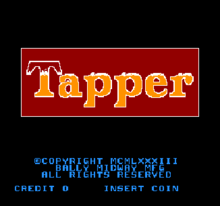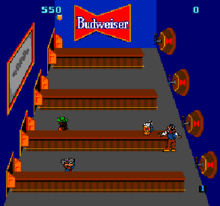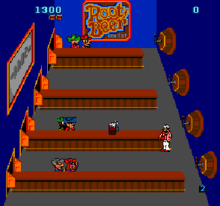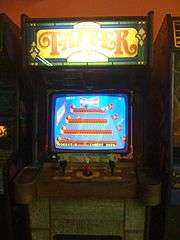Tapper (video game)
Tapper, also known as Root Beer Tapper, is a 1983 arcade game developed by Marvin Glass and Associates and released by Bally Midway.[1][2] Tapper puts the player in the shoes of a bartender who must serve eager, thirsty patrons (before their patience expires[3]) while collecting empty mugs and tips.
| Tapper | |
|---|---|
 | |
| Developer(s) | Marvin Glass and Associates |
| Publisher(s) | Bally Midway |
| Programmer(s) | Steve Meyer Elaine Ditton |
| Artist(s) | Scott Morrison |
| Composer(s) | Rick Hicaro |
| Platform(s) | Arcade, Atari 2600, Atari 8-bit, ColecoVision, Commodore 64, ZX Spectrum, MSX, Amstrad CPC, BBC Micro, IBM PC |
| Release |
|
| Genre(s) | Action |
| Mode(s) | Single-player, multiplayer |
| Cabinet | Upright and cocktail |
| Display | Horizontal orientation, Raster, standard resolution (Used: 512 x 480) |
Originally sponsored by Anheuser-Busch, the arcade version features a Budweiser motif.[4] It was intended to be sold to bars, with cabinets sporting a brass rail footrest and drink holders. Early machines had game controllers that were actual Budweiser beer tap handles, which were later replaced by smaller, plastic versions with the Budweiser logo on them.[5] The re-themed Root Beer Tapper followed in 1984, which was developed specifically for arcades because the original version was construed as advertising alcohol to minors.
Gameplay


The controls consist of a four-position joystick and a tap handle. The game screen features four bars, each with a keg at one end and a door at the other. Customers enter through the doors and slowly advance toward the kegs, demanding service. The player controls a bartender who must pour drinks and slide them down the bar for the customers to catch. Pushing the joystick up or down instantly moves the bartender to the keg at the next bar in the chosen direction, with the top and bottom of the screen wrapping around to one another, while pushing left or right causes him to run along the bar where he is stationed. When the tap handle is pulled down, the bartender instantly moves to the keg (if he is not already standing there) and fills a mug; releasing it causes him to slide the mug along the bar.
Customers slide back toward the doors upon catching a full mug, and disappear through the doors if they are close enough. If not, they stop after a certain distance, consume the drink, and resume their advance while sliding the empty mug back toward the keg. Customers occasionally leave tips on the bar, which the player can pick up for bonus points. Collecting a tip causes a group of female dancers to appear for a few seconds, distracting a portion of the customers so that they will stop advancing. However, distracted customers cannot catch drinks, and any customers who are either drinking or being pushed back at the start of the dancers' show will never be distracted.
One life is lost whenever any of the following occurs:
- The player fails to catch an empty mug before it falls off the keg end of a bar and breaks
- A full mug slides to the door end of a bar without being caught, where it falls and breaks
- Any customer reaches the keg end of a bar, whereupon they grab the bartender and slide him across the bar out the door
Each screen is completed when the bar is completely emptied of customers. The bartender then pours/consumes a drink of his own with humorous results involving the empty mug, such as getting it stuck on his head or stubbing his toe when he tries to kick it. As the game progresses, the customers appear more frequently, move faster along the bar, and are pushed back shorter distances when they catch their drinks. In addition, the maximum number of customers per bar gradually increases until every bar can have up to four customers at a time.
The player proceeds through four levels, each with its own theme and appropriately dressed customers, and must complete a set number of screens to advance from one level to the next. The levels are:
- A western saloon with cowboys (2 screens)
- A sports bar with athletes (3 screens)
- A punk rock bar with punk rockers (4 screens)
- An outer-space bar with aliens (4 screens)
A bonus round is played after the end of each level, in which six cans of beer (or root beer) are placed on the bar. A masked figure shakes five of the cans, then pounds the bar to shuffle them. Choosing the one unshaken can awards bonus points, while choosing any other results in the bartender being sprayed in the face (the unshaken can then flashes for a moment to show where it was).
After completing all four levels, the player returns to the start of the sequence and continues the game at a higher difficulty level.[6]
Music
Music and sound effects for the arcade version of Tapper were created Rick Hicaro of Marvin Glass & Associates. He used a Synclavier II synthesizer running with custom software written by Richard Ditton. The system interfaced directly to the arcade game system so sounds were true to the capabilities of the hardware.
The game's score includes "Oh! Susanna" (composed by Stephen Foster), "Buffalo Gals" (traditional American folk song), the Budweiser theme, and "Can-Can" by Jacques Offenbach. The rest of the music was written by Rick Hicaro.
Ports
Tapper was ported to the Apple II, Atari 8-bit family, Atari 5200, Atari 2600, BBC Micro, ColecoVision, Commodore 64, MSX, ZX Spectrum, IBM PC, and Amstrad CPC. Most of the home versions of Tapper featured the Mountain Dew logo, while the ZX Spectrum and Amstrad CPC versions had the Pepsi logo, but they retained the bartender character of the original arcade game instead of the soda jerk in Root Beer Tapper.
Reception
In Japan, Game Machine listed Tapper on their March 15, 1984 issue as being the most-successful table arcade unit of the year.[7] Compute!'s Gazette called the Commodore 64 version of Tapper "one of the most addictive games we've seen lately ... not only fun to play, but also immensely challenging, graphically entertaining, and full of action". The magazine stated that "it's a very well-designed strategy game", and concluded that it was "near the top in entertainment value".[8]
Legacy

The art style is almost identical to a previous game called Domino Man, and the following game Timber. In fact, the main character in Timber is a rework of the main character in Tapper. The art is based on Mike Ferris, an artist who taught Scott Morrison art.[9]
Re-releases
Root Beer Tapper has been included in several compilations. It was in the Nintendo 64 version of Midway's Greatest Arcade Hits, Arcade's Greatest Hits: The Midway Collection 2 for the PlayStation, Midway Arcade Treasures for PlayStation 2, Xbox, GameCube, and Microsoft Windows, and Midway Arcade Origins for PlayStation 3 and Xbox 360.[10]
A modern reinterpretation of the game for mobile devices, titled Tapper World Tour, was released in 2011.
Clones
Novasoft published a clone in 1984 called Brew Master for the TRS-80 Color Computer.[11] A slightly altered version of Tapper appears as the Milk Bar minigame in Barnyard (2006).[12] A similar version is on the virtual pet website Neopets as one of the minigames for the Altador Cup event.[13]
A clone called Nuka Tapper is included in Fallout 76 as a minigame with Fallout themed graphics.[14]
In popular culture
Tapper is one of the featured games in Disney's computer-animated film Wreck-It Ralph[15] (and its sequel Ralph Breaks the Internet) with the bartender voiced by Maurice LaMarche.
Competition
Officially recognized competition on Tapper first reached marathon status by Michael Ward whose score of 9,068,625 was verified by Twin Galaxies on July 3, 1985. Ward held the record for 18 years until Gregory Erway, on June 20, 2003, surpassed that record with a score of 9,100,175.
Erway held the record for 2 years until December 5, 2005 when Kelly Tharp of Louisville, KY achieved a score of 9,100,175 in Humble, TX at Totally Amused. This was at a Twin Galaxies sponsored event called "The Golden Age Showdown". This marathon game was authenticated by videotape and also by Twin Galaxies referees Dwayne Richard of Canada and Walter Day of Ottumwa, IA.
Tharp held the record for 10 years until William 'Snowflake' Rosa of Vermilion, OH achieved a score of 10,361,550 on October 18, 2015 which was officially recognized 10 days later on the 8th. The marathon lasted 19 hours, 42 minutes, and 24 seconds and took place at Full Blast Arcade in North Ridgeville, OH. As with previous scores, this was certified by Twin Galaxies.
Rosa held the record for 2 years until Lauren Featherstone completed a game with a score of 14,000,600. This game took place at Free Play Arcade in Arlington, TX on July 15, 2017.[16] Rosa reclaimed the world record on February 16, 2019 when he completed a game with a score of 14,826,200.[17]
References
- US patent 4643421, "Video game in which a host image repels ravenous images by serving filled vessels", issued 1987-02-17, assigned to Marvin Glass & Associates
- Mark J. Nelson (2015-08-04). "The 'Tapper' videogame patent". Retrieved 2015-08-11.
- CLASSIC GAMES REVISITED - Tapper (Atari 2600) review at Univision
- Undertow, CGR. "ROOT BEER TAPPER for Arcade Video Game Review".
- Rick Hicaro, former Marvin Glass & Associates employee; music composer/sound developer for Tapper
- Game entry at Giantbomb
- "Game Machine's Best Hit Games 25 - テーブル型TVゲーム機 (Table Videos)". Game Machine (in Japanese). No. 232. Amusement Press, Inc. 15 March 1984. p. 31.
- "Tapper". Compute!'s Gazette. January 1985. p. 113. Retrieved 6 July 2014.
- Retro Gamer magazine, issue 74. "The making of ... Tapper", page 67
- "Midway Arcade Origins Review". IGN. 2012-11-13. Retrieved 2018-05-08.
- Boyle, L. Curtis. "Brew Master". TRS-80 Color Computer Game List.
- "YouTube". www.youtube.com. Retrieved 2020-06-14.
- "Slushie Slinger | Game Guide | Jellyneo.net". www.jellyneo.net. Retrieved 2020-06-23.
- Dingman, Hayden (3 November 2018). "Fallout 76 B.E.T.A. impressions: Hell is other people". PCWorld. Retrieved 15 November 2018.
- "The Art of Bobby Pontillas". Retrieved 2013-03-30.
- "Arcade game classic 'Tapper' has a new queen: a yoga instructor from Plano | GuideLive". GuideLive. 2017-07-17. Retrieved 2017-07-17.
- https://www.twingalaxies.com/game/tapper/arcade/points-marathon/
External links
- Tapper at the Killer List of Videogames
- Video of the complete game
- Screenshots of a Tapper arcade machine at BasementArcade
- The arcade version of Tapper can be played for free in the browser at the Internet Archive
- The Atari 2600 version of Tapper can be played for free in the browser at the Internet Archive